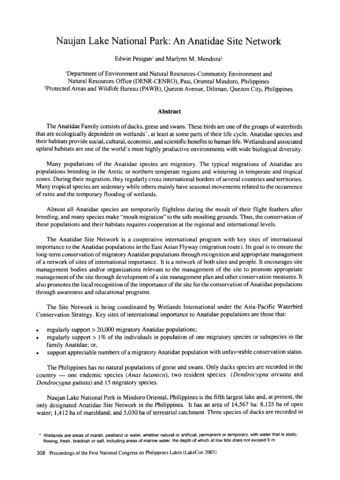| dc.contributor.author | Pesigan, Edwin | |
| dc.contributor.author | Mendoza, Marlynn M. | |
| dc.contributor.editor | Cuvin-Aralar, Maria Lourdes | |
| dc.contributor.editor | Punongbayan, Raymundo S. | |
| dc.contributor.editor | Santos-Borja, Adelina | |
| dc.contributor.editor | Castillo, Lourdes V. | |
| dc.contributor.editor | Manalili, Eduardo V. | |
| dc.contributor.editor | Mendoza, Marlynn M. | |
| dc.date.accessioned | 2021-07-28T01:20:37Z | |
| dc.date.available | 2021-07-28T01:20:37Z | |
| dc.date.issued | 2005 | |
| dc.identifier.citation | Pesigan, E., & Mendoza, M. M. (2005). Naujan Lake National Park: An Anatidae Site Network. In M. L. Cuvin-Aralar, R. S. Punongbayan, A. Santos-Borja, L. V. Castillo, E. V. Manalili, & M. M. Mendoza (Eds.), Proceedings of the First National Congress on Philippine Lakes (pp. 308-309). Southeast Asian Regional Center for Graduate Study and Research in Agriculture (SEARCA). | en |
| dc.identifier.issn | 1656-8099 | |
| dc.identifier.uri | http://hdl.handle.net/10862/6157 | |
| dc.description | Abstract only. | en |
| dc.description.abstract | The Anatidae Family consists of ducks, geese and swans. These birds are one of the groups of waterbirds that are ecologically dependent on wetlands*, at least at some parts of their life cycle. Anatidae species and their habitats provide social, cultural, economic, and scientific benefits to human life. Wetlands and associated upland habitats are one of the world s most highly productive environments with wide biological diversity.
Many populations of the Anatidae species are migratory. The typical migrations of Anatidae are populations breeding in the Arctic or northern temperate regions and wintering in temperate and tropical zones. During their migration, they regularly cross international borders of several countries and territories. Many tropical species are sedentary while others mainly have seasonal movements related to the occurrence of rains and the temporary flooding of wetlands.
Almost all Anatidae species are temporarily flightless during the moult of their flight feathers after breeding, and many species make moult migration to the safe moulting grounds. Thus, the conservation of these populations and their habitats requires cooperation at the regional and international levels.
The Anatidae Site Network is a cooperative international program with key sites of international importance to the Anatidae populations in the East Asian Flyway (migration route). Its goal is to ensure the long-term conservation of migratory Anatidae populations through recognition and appropriate management of a network of sites of international importance. It is a network of both sites and people. It encourages site management bodies and/or organizations relevant to the management of the site to promote appropriate management of the site through development of a site management plan and other conservation measures. It also promotes the local recognition of the importance of the site for the conservation of Anatidae populations through awareness and educational programs.
The Site Network is being coordinated by Wetlands International under the Asia-Pacific Waterbird Conservation Strategy. Key sites of international importance to Anatidae populations are those that:
- regularly support > 20,000 migratory Anatidae populations;
- regularly support > 1% of the individuals in population of one migratory species or subspecies in the family Anatidae; or,
- support appreciable numbers of a migratory Anatidae population with unfavorable conservation status.
The Philippines has no natural populations of geese and swans. Only ducks species are recorded in the country - one endemic species (Anas luzonica), two resident species (Dendrocygna arcuata and Dendrocygna guttata) and 15 migratory species.
Naujan Lake National Park in Mindoro Oriental, Philippines is the fifth largest lake and, at present, the only designated Anatidae Site Network in the Philippines. It has an area of 14,567 ha: 8,125 ha of open water; 1,412 ha of marshland; and 5,030 ha of terrestrial catchment. Three species of ducks are recorded in the area: Anas luzonica, Aythya fuligula and Dendrocygna arcuata. Aythya fuligula, a migratory species, has a biogeographical population in the East Asia Fly way of 500,000-1,000,000. Naujan Lake National Park supports an average of 11,000 individuals of Aythya which is estimated >1% of its bio-geographical population. The Lake is also a Ramsar Site (wetlands of international importance).
The site management authority is the Regional Executive Director, Department of Environment and Natural Resources-Region IV, 1515 L&S Bldg., Roxas Blvd., Ermita, Manila. Tel: (+63-2) 5212064, Fax: (+63-2) 5212253.
If you are aware of areas with large number of ducks, please contact Marlynn M. Mendoza of the Protected Areas and Wildlife Bureau (PAWB). Telefax: (+63-2) 9258950, Email: mmendoza@i-manila.com. | en |
| dc.language.iso | en | en |
| dc.publisher | Southeast Asian Regional Center for Graduate Study and Research in Agriculture (SEARCA) | en |
| dc.subject | Anatidae Site Network | en |
| dc.subject | Naujan Lake National Park | en |
| dc.subject | Aythya fuligula | en |
| dc.subject | Anatidae | en |
| dc.subject | Aythya | en |
| dc.title | Naujan Lake National Park: An Anatidae Site Network | en |
| dc.type | Conference paper | en |
| dc.citation.spage | 308 | en |
| dc.citation.epage | 309 | en |
| dc.citation.conferenceTitle | Proceedings of the First National Congress on Philippine Lakes | en |
| dc.subject.asfa | aquatic birds | en |
| dc.subject.asfa | migratory species | en |
| dc.subject.scientificName | Anas luzonica | en |
| dc.subject.scientificName | Dendrocygna arcuata | en |
| dc.subject.scientificName | Dendrocygna guttata | en |


